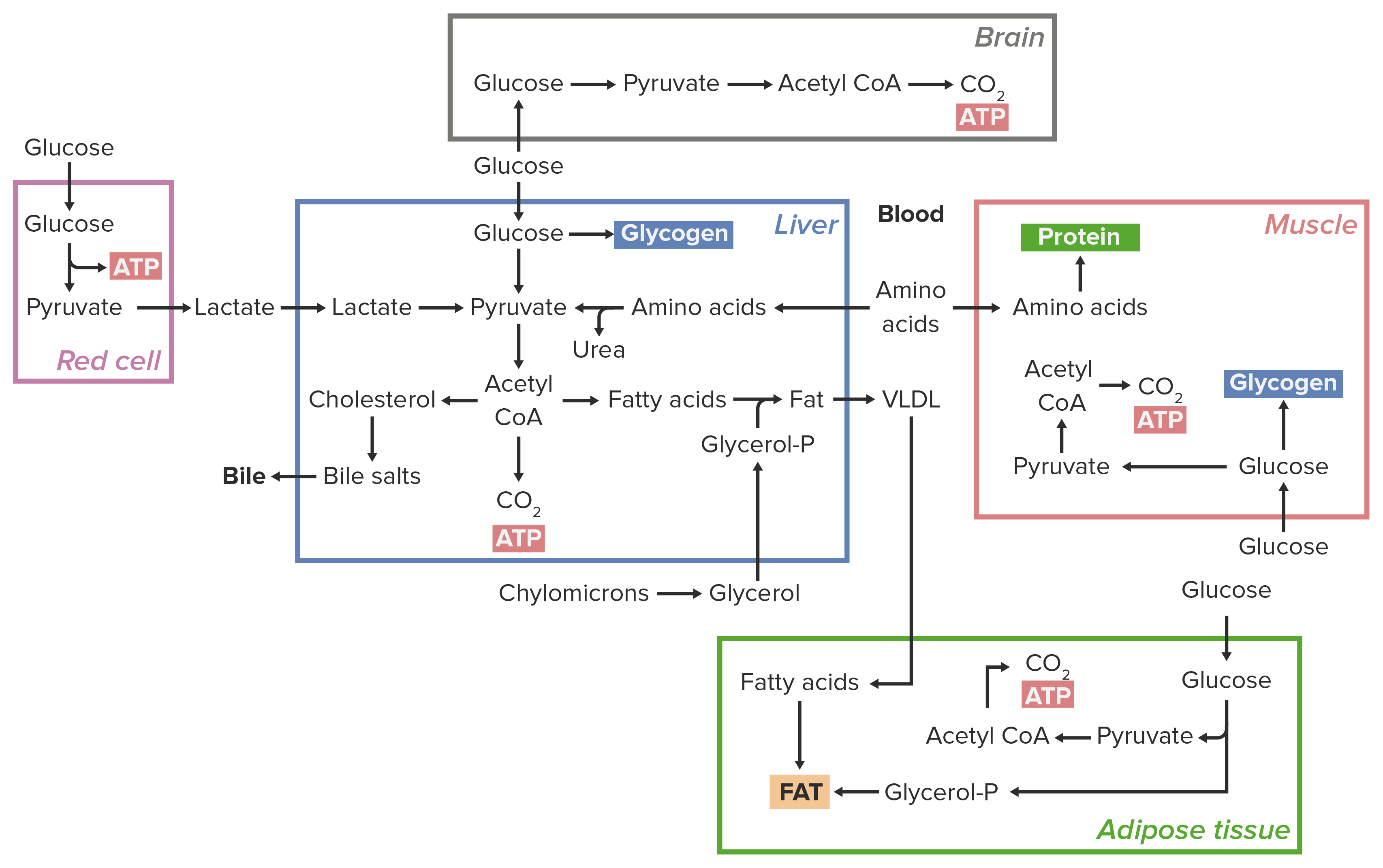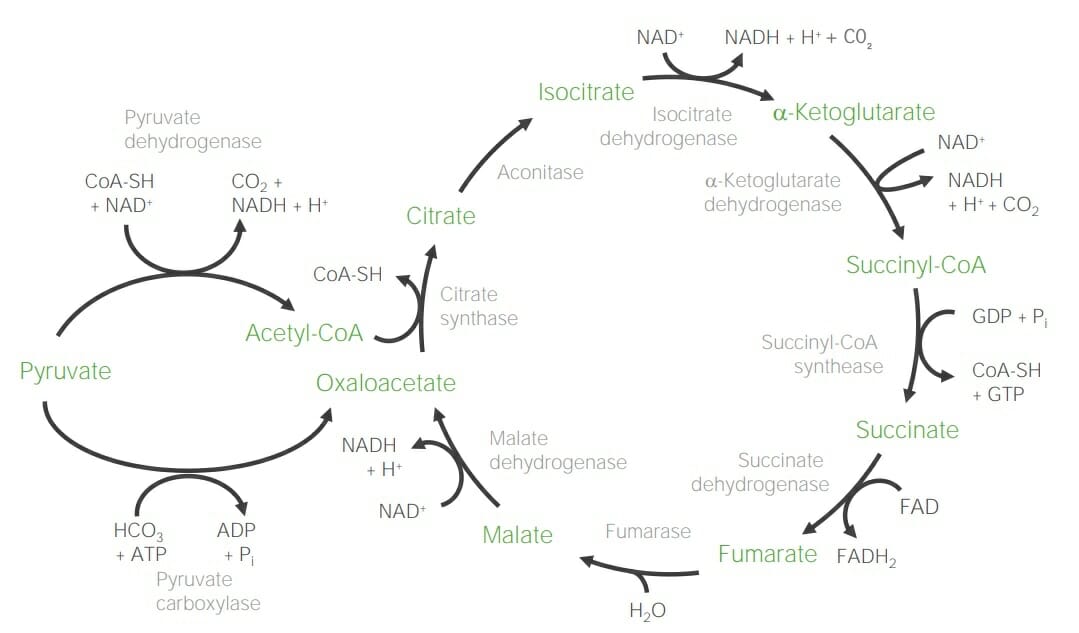Playlist
Show Playlist
Hide Playlist
Krebs Cycle
-
Slides 17 KrebsETCChemiosmosis CellBiology.pdf
-
Reference List Molecular and Cell Biology.pdf
-
Download Lecture Overview
00:01 The first part we start with is Krebs cycle. However, Krebs cycle has a few different names. 00:06 We could call it the Tri-carboxylic acid cycle or TCA cycle for short, or you could call it the citric acid cycle. 00:16 These are all naming conventions with different reasons but they do all mean precisely the same thing. 00:22 So, whatever we want to call it let's get moving. In the Krebs cycle, we see that it is a cycle. 00:29 Recall that we have 6 carbons originally going into cellular respiration. They went through glycolysis they got split into 3 carbon molecules. And then we went through pyruvate oxidation. Loss 1 CO2 and we're left with 2 carbon molecules of Acetyl-CoA. Now, those 2 carbon molecules for each Acetyl-CoA are going to get cut apart again in this process of the Krebs cycle. So it's the exciting part. 01:03 We lose all of our carbons. We'll now have all of our energy trapped in the electron carriers. 01:09 We've got excited kids to continue the analogy. The girls are the electrons. The boys are the protons or the hydrogen ions and they are really excited to go to the main event. The dance, the prom whatever you want to consider it. There are going to get in their taxis and head there with all their energy. 01:26 So the cycle, because we have 2 Acetyl-CoA's remaining, we'll go around two times. And so the accounting that I'm going to follow is going to be for the original glucose. We have 2 carbons for each pyruvate or Acetyl-CoA going in here. So we have 4 of the original carbons left. We're going to track those. 01:49 The energy that we are capturing from this is potential energy. In the cars already to head to the dance and there is so much excitement in there and you'll see precisely how that is all yielded at the end of that process. 02:06 So, let me introduce the Krebs cycle. First of all, it is a cycle. And it's a cycle because we have a workbench. The workbench is the original piece and it will be recycled at the end of the cycle in order to pick up more stuff to work on. So the workbench is here and we are going to add the 2 carbon Acetyl-CoA onto the workbench. Recall we go around two times so we have two 2 carbon molecules that will get taken care off in the two cycles. So, we attach that to the workbench and it's a little bit more complicated. 02:44 You'll understand the details of what happens in Biochemistry, but we attach the 2 carbons on and things rearrange and then we cut 2 carbons off. It's not as simple as tacking them on and then chopping one off and then the other off. You'll see in the first phase here, we'll go from citrate to α-ketoglutarate. 03:04 You don't need to commit those to memory just yet but it's not a bad intermediate to know. 03:10 In that step we see that 1 carbon is cut off and is released in the form of carbon dioxide. 03:17 When you think of the whole equation involved in cellular respiration, this is where the carbon dioxide comes from. 03:24 And then you will see we will get another carbon dioxide in the second phase of the cycle. 03:29 At the same time as we have carbon dioxides being made, we'll see that electrons are picked up. 03:37 So this makes sense. As we cut the bonds between carbons we will release energy which for now is going to be picked up in our taxis or limousines or electron carriers and held until we get to the final phase. 03:52 So, now we've got rid off all of the original carbons. The first ones we lost from the 2 pyruvate in pyruvate oxidations. Now, we lose two more in the stages between citrate and α-ketoglutarate. 04:09 One for each Acetyl-CoA that went in, and we'll lose two more to the α-ketoglutarate and Succinyl-CoA stage. 04:18 One for each of the Acetyl-CoA's that got tacked on to the workbench. Then we move on into the next piece of the cycle and we get a teeny bit of ATP. Just one for for each Acetyl-CoA that goes through the cycle. 04:32 So we'll have two of those. In addition you'll see that we have the FAD player coming in here. 04:39 So, NAD does its normal thing. Picks up its two protons two electrons. All good to go. And then FAD does exactly the same thing. Two protons, two electrons. It's a little lesser energy of a car. 04:53 You could think a bit like it's the economy version. Maybe it's the taxi and the NAD is the limousine. 04:59 However you want to go with it. But it does the same thing at a little bit lower energy level. 05:04 As you'll see when we get to the electron transport chain and chemiosmosis. 05:10 So, we see that the workbench again is recycled. That's why it is TCA cycle, Krebs cycle, whatever cycle you want to call it. The workbench is regenerated. It will pick up two more Acetyl-CoA's and continue going around. But the original molecule oxaloacetate, the 4 carbon workbench will pick up more and continue cycling. So, in summary, recall we are keeping track of carbons. We're keeping track of electron carriers. And we're keeping track of ATP. So ask yourself which of these you've got. 05:50 First of all did we get any carbons? Well yes we did. We got 2 carbons from each of the Acetyl-CoA's going into the cycle. So a total of 4 carbons were burned and we have no glucose left from our original glucose molecule. There are none of those original carbons leftover. Do we get any electron carriers? Well, certainly we do. We're going to get 6 NADH's per glucose or 3 per cycle. 06:23 But we have another electron carrier in here. So, we need to keep track of that one. 06:28 We get one more FADH2 with more electrons getting ready to go to the main event. 06:36 So we've covered carbons. We've covered our electron carriers. The last thing to cover? ATP. 06:43 Do we get any ATP? Yes, we get 1 measly little ATP from the Krebs cycle. 06:50 It actually starts out being a GTP but that's kind of incidental so we'll just count it as 1 ATP. 06:56 Now, we move on with all of these electron transporters to the electron transport chain.
About the Lecture
The lecture Krebs Cycle by Georgina Cornwall, PhD is from the course Energy, Enzymes and Metabolism.
Included Quiz Questions
What are the products formed in the Krebs cycle from one molecule of glucose?
- 4 CO2, 6 NADH, 2 FADH2, 2 ATP
- 1 CO2, 2 NADH, 1 FADH2, 1 ATP
- 2 CO2, 6 NADH, 2 FADH2, 2 ATP
- 2 CO2, 3 NADH, 1 FADH2, 1 ATP
- 4 CO2, 12 NADH, 4 FADH2, 4 ATP
In the Krebs cycle, which molecule is produced each time a carbon dioxide molecule is generated?
- NADH
- ATP
- GTP
- FADH2
- FAD+
Removal of coenzyme A from succinyl CoA produces which of the following?
- ATP
- NAD+
- FAD
- A five-carbon molecule
- UDP
Customer reviews
3,0 of 5 stars
| 5 Stars |
|
1 |
| 4 Stars |
|
0 |
| 3 Stars |
|
0 |
| 2 Stars |
|
0 |
| 1 Star |
|
1 |
adioasd oiaj doias ds dioas jdoias jdoas djoi asdjoia sd o
It is a good explanation for a complex topic, with only the most important





